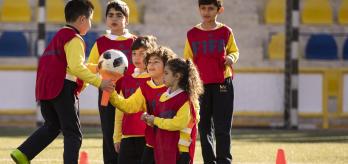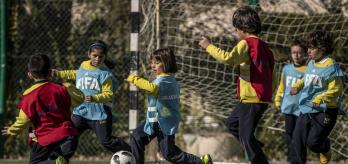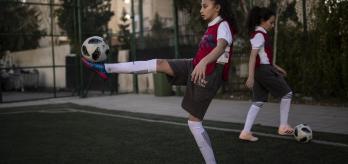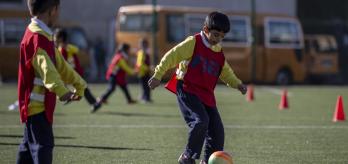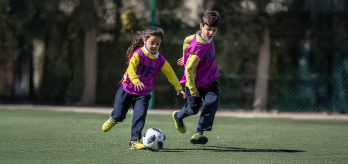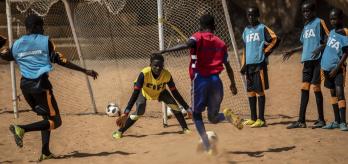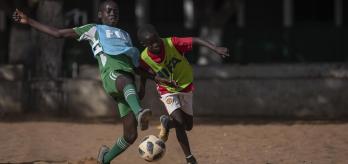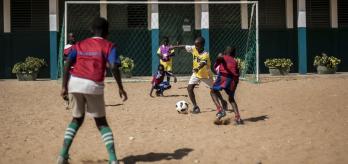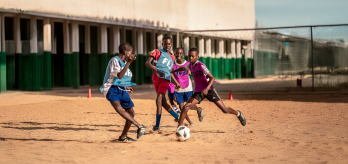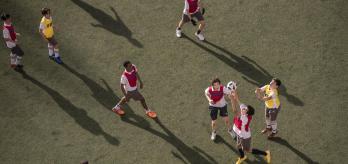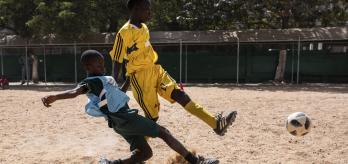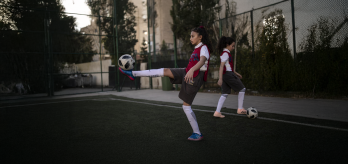In this final edition of FIFA’s Grassroots Coaching Essentials, Dr Jené Baclawski introduces the Play-Practice-Play model, a child-centred approach that places playing the game at the core of every training session. By beginning and ending with normal play, coaches can create an environment that is both enjoyable and focused on player development.
The Play-Practice-Play framework guides coaches through three clear phases: begin with small-sided games, move into core skill practice with plenty of repetition, and finish with open play where players can apply what they learned in the previous two phases.
Below, you will find Jené’s presentation explaining how to bring the Play-Practice-Play model to life on the pitch. Following the video is a written summary of the main talking points and three age-appropriate activities that grassroots coaches can employ in their own sessions.
Phase 1: Play
The opening phase of Play-Practice-Play is all about getting players straight into the action, giving them the chance to start the session with the ball at their feet and make their own decisions within the game. In this section, Jené highlights how coaches can use this initial phase to create an engaging, game-like environment that sets the tone for the rest of the session:
-
Why start with play: Begin each session with an activity that resembles a real match, so that players explore and experiment instinctively. This ensures that the game remains the primary teacher.
-
Foster team dynamics: Encourage players to face a variety of opponents in-game through rotation, helping them to adapt their skills and collaborate more effectively with team-mates.
-
Tailor to players’ needs: Coaches should tailor the activity to the needs and skill levels of the players by modifying team size, pitch dimensions or rules, keeping it engaging but ensuring that it remains challenging.
Phase 2: Practice
The second phase of Play-Practice-Play acts as a gap between the two game-oriented phases. It provides coaches with an opportunity to develop core skills that need to be worked on, having watched the players closely in the first phase. Here, Jené outlines how grassroots coaches can make the most of ‘Practice’ by concentrating on three key principles:
-
Focus on skill development: For this phase, design sessions so that players can concentrate on developing particular skills in a structured environment, building mastery through repeated, focused practice.
-
Adjust the challenge: Like the previous phase, it is important to make sure every player remains involved and is challenged properly by adapting tasks to suit their individual skill levels.
-
Provide thoughtful feedback: Coaches can use this stage to offer constructive, personalised feedback to players, guiding them to improve and fine-tune their skills.
Phase 3: Play 2
The final phase is a return to play and offers players the chance to put what they learned in the previous activity into practice in a game-like setting. Additionally, it allows coaches to observe how the players are applying these learned skills. In this section, Jené explains how to make the most out of this portion of the model:
-
Apply learned skills: Give players the chance to apply their recently practised skills in a realistic, game-like environment, with fewer restrictions or rule modifications.
-
Coaching behaviour is important: This phase allows coaches to observe carefully how players have put what they’ve learned into practice, focusing on decision-making and applying skills under pressure in a match-like situation.
-
Emphasise free play: Coaches should encourage players to solve game situations and experiment independently, adapting to the activity and making decisions based on what unfolds during the game.
Key Take-aways
By using this model during sessions, coaches can create an environment where young players learn enthusiastically while building essential skills. Here is a summary of the key take-aways from Jené’s presentation on Play-Practice-Play:
-
Child-centred learning: The Play-Practice-Play model helps young players learn naturally and enjoyably, supporting development through play.
-
Game-focused development: Starting and ending with play keeps the game central, ensuring both enjoyment and key developmental progress in a game-like setting.
-
Encourage decision-making and creativity: The model empowers players to make decisions, fostering creativity and problem-solving while building essential skills.


